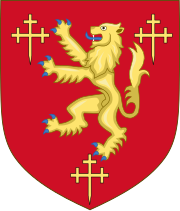Earls of Essex
| Earldom of Essex | |
|---|---|
 
Arms of Capell, Earl of Essex: Gules, a lion rampant, between three cross crosslets fitcheeé or
|
|
| Creation date | 1139 (first creation) 1199 (second creation) 1239 (third creation) 1376 (fourth creation) 1461 (fifth creation) 1540 (sixth creation) 1543 (forfeit 1553-59)(seventh creation) 1572 (eighth creation) 1671 (ninth creation) |
| Monarch |
Stephen (first creation) John (second creation) Henry III (third creation) Edward III (fourth creation) Edward IV (fifth creation) Henry VIII (sixth creation) Henry VIII (seventh creation) Elizabeth I (seventh creation, restoration) Elizabeth I (eighth creation) Charles II (ninth creation) |
| Peerage | Peerage of England |
| First holder | Geoffrey de Mandeville, 1st Earl of Essex |
| Present holder | Paul Capell, 11th Earl of Essex (ninth creation) |
| Heir presumptive | William Jennings Capell |
| Subsidiary titles | Viscount Malden Baron Capell of Hadham |
| Former seat(s) | Cassiobury House |
| Armorial motto | Fide et fortitudine (By faith and fortitude) |
Earl of Essex is a title in the Peerage of England which was first created in the 12th century by King Stephen of England. The title has been recreated eight times from its original inception, beginning with a new first Earl upon each new creation. Possibly the most well-known Earls of Essex were Thomas Cromwell (c. 1485 – 1540) (sixth creation), chief minister to King Henry VIII, and Robert Devereux, 2nd Earl of Essex (1565–1601) (eighth creation), a favourite of Queen Elizabeth I who led the Earl of Essex Rebellion in 1601.
The current holder of the earldom is Paul Capell, 11th Earl of Essex (b. 1944), a retired school teacher from Caton, Lancashire.
The family seat was Cassiobury House, near Watford, Hertfordshire.
The title was first created in the 12th century for Geoffrey de Mandeville, 1st Earl of Essex (d. 1144). Upon the death of the third earl in 1189, the title became dormant or extinct. Geoffrey Fitz Peter, who had married Beatrice de Say, granddaughter of the first earl's sister and eventual heir to the Mandeville honour, gained the earldom in 1199 at its second creation by King John. The Essex title passed to two of Fitz Peter's sons before again becoming extinct after the death of the second, William, the 3rd Earl of Essex, who had taken the surname de Mandeville.
The third creation was for Humphrey de Bohun, 2nd Earl of Hereford in 1239, whose father Henry had married Maud, sister of the sixth earl. All three of the Earldoms of Hereford, Northampton and of Essex became extinct in 1373. There were several more creations before the famous Devereux creation in 1572, which included Robert Devereux, 2nd Earl of Essex (1566–1601) a favourite of Queen Elizabeth I and his son Robert Devereux, 3rd Earl of Essex, the general who commanded the Parliamentary army at the Battle of Edge Hill, the first major battle of the English Civil War (for further history of the Devereux family, see the Viscount Hereford). Upon its extinction, the present creation was made in 1661.
...
Wikipedia
